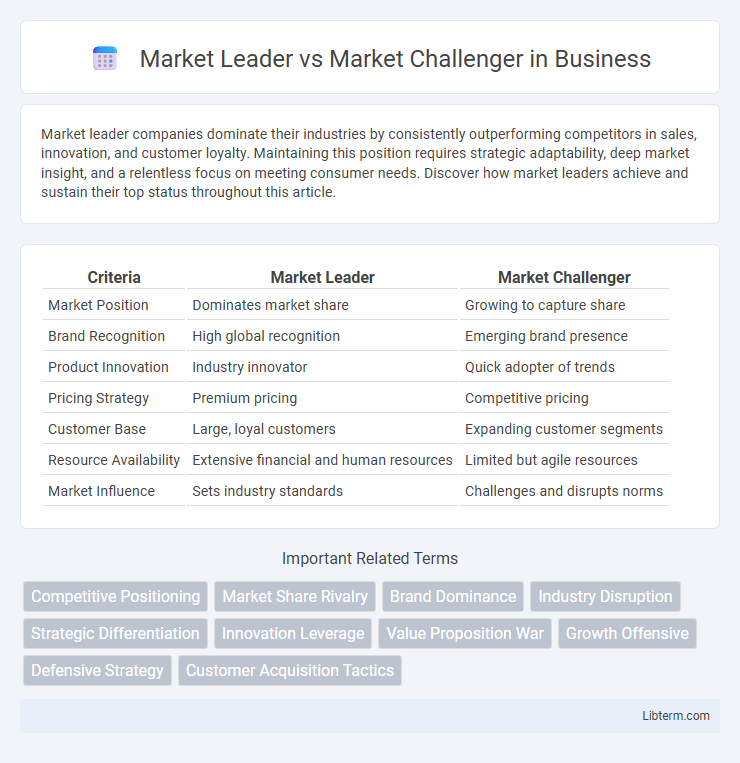Market leader companies dominate their industries by consistently outperforming competitors in sales, innovation, and customer loyalty. Maintaining this position requires strategic adaptability, deep market insight, and a relentless focus on meeting consumer needs. Discover how market leaders achieve and sustain their top status throughout this article.
Table of Comparison
| Criteria | Market Leader | Market Challenger |
|---|---|---|
| Market Position | Dominates market share | Growing to capture share |
| Brand Recognition | High global recognition | Emerging brand presence |
| Product Innovation | Industry innovator | Quick adopter of trends |
| Pricing Strategy | Premium pricing | Competitive pricing |
| Customer Base | Large, loyal customers | Expanding customer segments |
| Resource Availability | Extensive financial and human resources | Limited but agile resources |
| Market Influence | Sets industry standards | Challenges and disrupts norms |
Defining Market Leaders and Market Challengers
Market Leaders hold the largest market share within an industry, setting pricing standards and influencing market trends through strong brand recognition and customer loyalty. Market Challengers aggressively target these leaders by innovating product offerings, enhancing customer experiences, and employing competitive pricing strategies to capture increased market share. Both roles drive market dynamics, shaping competitive landscapes and consumer choices through strategic positioning and resource allocation.
Key Characteristics of Market Leaders
Market leaders dominate their industries through high market share, strong brand recognition, and extensive distribution networks. They drive innovation, set pricing strategies, and influence customer preferences, maintaining a consistent competitive advantage. Their robust financial resources enable significant investment in marketing, research, and expansion, solidifying their position at the forefront of the market.
Strategies Employed by Market Challengers
Market challengers deploy aggressive strategies such as frontal attacks, focusing on matching or surpassing market leaders on price, product quality, and distribution. They often use indirect or flanking attacks by targeting unserved customer segments or niche markets to gradually erode the leader's dominance. Strategic alliances, innovation, and marketing differentiation are also critical tactics to disrupt incumbent market positions and gain competitive advantage.
Strengths and Weaknesses Comparison
Market leaders hold the advantage of strong brand recognition, extensive customer base, and significant market share, enabling economies of scale and pricing power, yet they may struggle with complacency and slower innovation. Market challengers exhibit agility, aggressive tactics, and innovation drive to capture market segments but often face resource limitations and weaker customer loyalty compared to leaders. Understanding these strengths and weaknesses informs strategic positioning and competitive responses in dynamic markets.
Market Share and Competitive Positioning
Market leaders dominate the market with the highest market share, often exceeding 40%, establishing strong competitive positioning through brand loyalty and extensive distribution networks. Market challengers hold significant market shares, typically between 20% and 40%, aggressively targeting leaders by innovating pricing strategies, marketing campaigns, and product differentiation to capture additional market segments. Both positions require strategic resource allocation, but market leaders leverage scale advantages while challengers focus on disruptive tactics to alter competitive dynamics.
Innovation and Product Development Approaches
Market Leaders invest heavily in innovation to maintain their dominant position, emphasizing continuous improvement, advanced research and development, and cutting-edge technologies to create superior products that set industry standards. Market Challengers adopt agile, disruptive strategies, often targeting niche markets or unmet customer needs with innovative features and faster product development cycles to capture market share. Both rely on customer insights and competitive analysis, but Market Leaders typically focus on sustaining innovation, while Challengers prioritize breakthrough innovations to differentiate themselves.
Pricing and Promotional Strategies
Market leaders often leverage premium pricing strategies supported by widespread promotional campaigns to maintain brand dominance and customer loyalty. Market challengers typically adopt competitive pricing, including discounts and aggressive promotions, to capture market share and disrupt the leader's influence. Both use targeted advertising and sales incentives, but challengers focus more on value-based offers to attract price-sensitive consumers.
Brand Loyalty and Customer Perception
Market leaders typically benefit from strong brand loyalty due to established market presence, consistent product quality, and widespread consumer trust, which enhance customer retention and brand equity. Market challengers often focus on innovative strategies and aggressive marketing campaigns to shift customer perception, aiming to disrupt the status quo and attract dissatisfied or undecided consumers. Effective management of brand loyalty and shaping positive customer perceptions are crucial competitive advantages that differentiate market leaders from challengers in dynamic industries.
Case Studies: Success Stories and Failures
Market leaders like Apple and Amazon demonstrate success through innovation and customer loyalty, dominating market share while continuously expanding product ecosystems. Market challengers such as Netflix initially disrupted traditional media but faced failures in premium-priced streaming models and content missteps that underscore risks in aggressive market positioning. Case studies reveal that sustained innovation and strategic differentiation are crucial for both leaders and challengers to capitalize on growth opportunities and avoid market stagnation.
Future Trends and Evolving Dynamics
Market leaders are leveraging artificial intelligence and big data analytics to predict consumer behavior and maintain their competitive edge, while market challengers invest heavily in innovation and agile business models to disrupt established markets. Emerging trends such as sustainability, digital transformation, and personalized customer experiences are reshaping competitive dynamics, forcing both leaders and challengers to adapt rapidly. The future landscape will be dominated by companies that integrate advanced technologies with strategic flexibility, enabling them to capture evolving market demands and create new growth opportunities.
Market Leader Infographic

 libterm.com
libterm.com